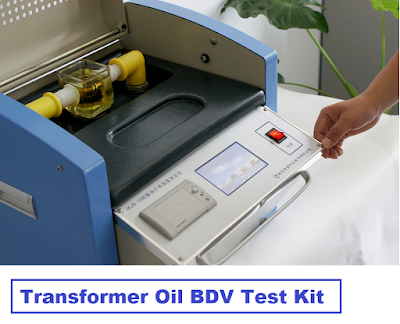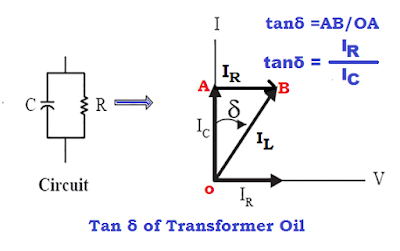This article describes transformer oil testing, oil types, and their properties. Transformer Insulating Oil is used in the transformer for insulation and cooling purposes.
What is Transformer Oil?
The transformer oil is obtained by fractional distillation and subsequent treatment of crude petroleum, and the transformer oil is also known as Mineral Insulating oil.

The heat generated in the transformer gets transferred to oil, and the heat gained by the transformer oil gets transferred to the transformer radiators through convection. Finally, the heat is released from the transformer radiator to the air through radiation. Mineral oil is a good conductor of heat and a bad conductor of electricity. This virtue of mineral-insulated oil makes it most suitable for oil-filled transformers.
The transformer insulating oil also protects the winding and core of the transformer. It acts as an insulation between the core and winding and thus stops any oxidation reaction by avoiding direct contact of the oxygen with the core and winding.
Table of contents
Types of Transformer Oil
There are two types of transformer Mineral oil.
- Naphtha-based Transformer Insulation Oil
- Paraffin-based Transformer Insulation Oil
Naptha Oil
Naptha oil gets more easily oxidized than paraffin oil. When the oil gets oxidized, a product is formed called sludge. The sludge formed in the Naptha oil is more soluble than paraffin oil, and it does not settle down in the bottom of the transformer tank. The sludge formed does not obstruct the convection circulation of the oil, and thus, the cooling of the transformer does not get affected.
Paraffin Oil
The oxidation rate of the paraffin oil is lower than the Neptha oil. Still, the sludge is insoluble, and the sludge gets precipitated at the bottom of the transformer tank and affects the cooling of the transformer. The paraffin oil has more wax content in it. Paraffin-based oil is cheaper than Neptha oil.
Properties of Transformer Insulating Oil
Some of the parameters of the transformer oil must be considered for the long life of a transformer.
Parameters of Transformer Oil
The transformer oil parameters can be categorized as;
| Transformer Oil Characteristics | Parameters |
| Electrical Parameters | Dielectric strength, dielectric dissipation factor, and specific resistance |
| Chemical Parameters | Water content, Acidity, and Sludge content |
| Physical Parameters | Inter facial Tension, Viscosity, Flash point and Pour point |
1. Electrical Properties of Transformer Oil
Dielectric Strength
The dielectric strength of oil is also known as breakdown voltage(BDV). The breakdown voltage of transformer oil is the maximum voltage for which the transformer oil remains in an insulating state. If the voltage exceeds the BDV of the transformer oil, the current starts flowing through the oil, and the transformer oil loses its insulating property.
The breakdown voltage of the transformer oil is tested using a transformer oil BDV test kit. The transformer oil BDV test kit has two electrodes separated by a 2.5 mm distance. A transformer oil BDV test kit with 4 mm electrode separation is also used. The breakdown voltage is measured by observing the voltage at which the sparking is observed between the electrodes.

The voltage is increased at a rate of 2 KV/sec. The voltage is noted when the spark is observed. The same sample is tested six times, and the breakdown voltage is measured. The average of all six readings of breakdown voltage is the final breakdown voltage of the transformer oil.
The lower BDV of oil indicates moisture and other conducting substances in the oil. The clean oil with low moisture content has higher BDV than the oil with high moisture content and other impurities. As per IEC, the transformer oil with a minimum breakdown voltage of 30 KV can be safely used in a transformer.
The standards IEC60156/ ASTM D-877 / IS6792 can be referred to for transformer oil BDV measurement.
Dielectric Dissipation Factor
The dielectric dissipation factor of the transformer oil is tangent of the delta angle, which shows the dielectric loss of oil. Dielectric dissipation factor is also known as tan delta(tan δ) transformer oil. The dielectric dissipation or loss factor is measured according to IEC 60247/ ASTM D1169/ IS 6262 standards. A high tangent delta of the transformer oil indicates the deterioration of the oil. If the tan delta of the transformer is more than 0.05% at 25 °C, the transformer should be analyzed in a laboratory to determine the cause of the high dissipation factor.
When the insulating material is placed between the live and earth parts, the leakage current will flow. The magnitude of the leakage current indicates the quality of the insulation. The transformer oil is an insulating or dielectric material. The leakage current flowing through the oil indicates the quality of the transformer oil.
In an ideal insulating or dielectric material, the leakage current flowing through it must lead the voltage by 90 degrees. However, in reality, the current flowing through the insulating material does not lead the voltage by 90° but leads by something less than 90°. The extent to which the phase shift is less than 90° indicates the deterioration of the insulation quality.

The perfect insulator must draw a capacitive current, and the resistive current must be zero. The more the resistive current, the more the dielectric dissipation factor or tan delta or loss angle.
The loss angle or tan delta must be as low as possible for better insulation. If the loss angle is small the resistive component of the current is small, which indicates a high resistive property of the insulating material. The high resistive insulation is a good insulator. The high value of the tan delta indicates that there are impurities in the transformer oil.
The resistivity and the tan delta have an inverse relationship. The transformer oil with a lower loss angle or tan delta has higher resistivity.
Specific Resistance
The specific resistance is proportional to its resistivity and length and inversely proportional to the cross-sectional area. The specific resistance also depends on the temperature of the transformer oil.
The specific resistance of the transformer oil is a measurement of DC resistance between two opposite sides on one cm3 block of oil. The unit is Ohm-cm at a specific temperature. The resistivity of the oil reduces drastically with an increase in temperature. If the transformer is shut off for a long time, the temperature of the transformer oil is the same as that of the ambient, and the resistivity of the transformer oil increases. With a full load, the temperature of the transformer oil may reach up to 90 °C, especially in overloaded conditions.
Thus, the transformer oil resistance should accommodate the two values of the specific resistance at 27 °C and 90 °C.
The specific resistance of the transformer oil can be measured using the standard IEC 60247/ ASTM D-1169/ IS 6103.
As per IEC 60247, the electrification time and field strength proposed are 60 seconds and 250V/mm, respectively. The voltage and current ratio are measured to calculate the specific resistance of the transformer oil.
As per ASTM D-1169, the electrification time and the field strength proposed are 60 seconds and 200 V/mm, respectively. In this process, the specific resistance of the oil is measured by applying both polarity voltage and the average of both readings, which is the specific resistance of the transformer oil.
The minimum specific resistance of the transformer oil at 90 and 27 °C is 35 x1012 and 1500 x1012, respectively.
2. Chemical Properties of Transformer Oil
Water Content
The water content in transformer oil is a very undesirable pollutant. The dielectric strength of the transformer oil lowers with an increase in the moisture content in the transformer oil. The breather of the transformer is filled with moisture-absorbent material, silicon gel so that water does not come in contact with the transformer oil.
The paper of the transformer is highly hygroscopic. The paper absorbs the moisture of the oil, and thus, the paper insulation property deteriorates. With an increase in temperature, the absorbed moisture in the paper is released, and it gets mixed with the transformer oil.
The transformer’s life reduces with increased moisture content in the transformer oil. The water content is measured in ppm(parts per million units).
As per IS-335, the water content in an oil is allowed up to 50 ppm.
Acidity
When the transformer oil comes in contact with the air, the oil gets oxidized. The oxidization process further accelerates with the increased temperature of the transformer. The resistivity of the transformer oil decreases with increased oxidization. The acidity of oil deteriorates the insulation property of the paper. With the increased acidity of the transformer oil, the water becomes more soluble.
The acidity test of the transformer oil is carried out periodically to check its acidity. The acidity of the transformer oil is expressed in mg of KOH required to neutralize 1 gram of transformer oil.
3. Physical Properties of Transformer Oil
Flash Point
The flash point of transformer oil is the minimum temperature at which it gives off vapor. If the ignition source comes in contact with the vapor-air mixture, it catches fire. The flash point of transformer oil is 140.
No burning occurs below the flash point. A high flash point of transformer oil is desirable. This property of the transformer oil is very important, especially considering the fire hazards associated with it.
Pour Point
The pour point is the minimum temperature at which transformer oil starts flowing. Paraffin oil has a higher pour point than naphtha oil because paraffin oil has more wax content than naphtha oil. Paraffin oil is suitable for warm climate conditions.
Viscosity
The resistance to flow is known as the viscosity of the liquid. The resistance to flow obstructs the convection circulation of oil inside the transformer. The viscosity lowers with an increase in the temperature; it flows faster or more efficiently. Good transformer oil should have a low viscosity so that it offers less resistance to flow and does not affect the cooling of the transformer.
Inter Facial Tension(IFT) of Transformer Oil
The interfacial tension describes the tension between two liquids. In the case of the transformer, oil, and water—the attractive molecular force between water and oil measures interfacial tension. The impurity in the oil or contamination of the transformer oil lowers the IFT. The unit of IFT is dyne/cm or milli-Newton/meter.
Transformer Oil Testing
The transformer oil must be periodically tested to ensure the trouble-free operation of the transformer. The transformer oil is a critical key factor for the reliable operation of the transformer. International standards set various testing standards and procedures, most of which are set by ASTM. The following transformer oil parameters are tested using the ASTM( American Society for Testing and Materials) standard,
- Standard Specifications for Mineral Insulated Oil used in Electrical Apparatus (ASTM D3487)
- Dielectric Breakdown Voltage (ASTM D877)
- Interfacial Tension(IFT) (ASTM D971)
- Acid Number (ASTM D664)
- Specific Resistance (ASTM D1169)
- Liquid Power Factor (ASTM D924-08)
- Corrosive Sulphur (ASTM D1275)
- Visual Examination (ASTM D1524)
The above tests are carried out on transformer oil as per the procedure and standards specified by ASTM to ensure that the transformer oil parameters are as per the specifications of the transformer oil. Any deviation in the oil parameter shows contamination of the transformer oil, and the oil must be replaced with a new transformer in the transformer.
Apart from the above tests, the Dissolved Gas Analysis(DGA) Test is also conducted to determine the health of the transformer oil. The DGA test is helpful for predictive maintenance of the transformer.
2 thoughts on “Transformer Oil | Testing, Types and Properties”